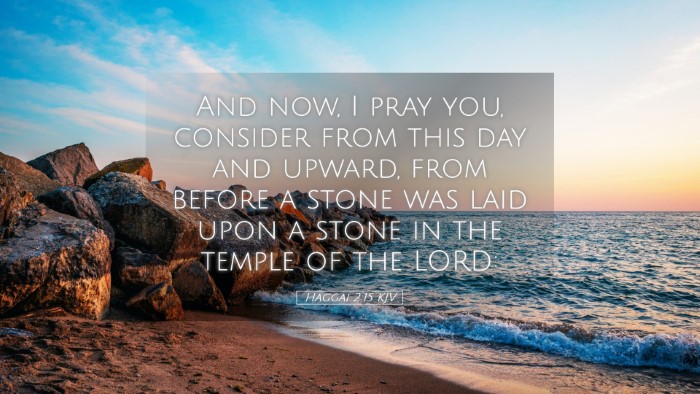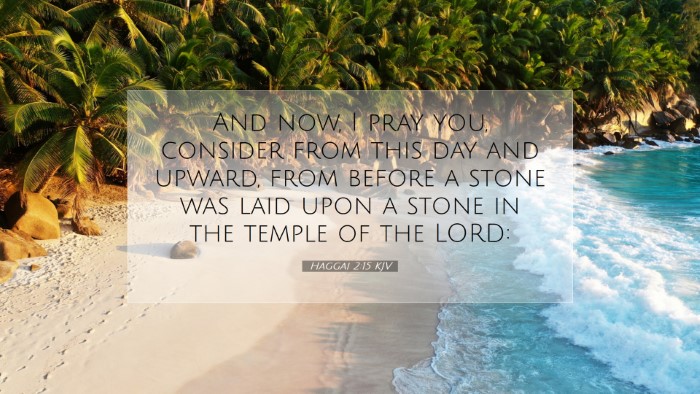Old Testament
Genesis Exodus Leviticus Numbers Deuteronomy Joshua Judges Ruth 1 Samuel 2 Samuel 1 Kings 2 Kings 1 Chronicles 2 Chronicles Ezra Nehemiah Esther Job Psalms Proverbs Ecclesiastes Song of Solomon Isaiah Jeremiah Lamentations Ezekiel Daniel Hosea Joel Amos Obadiah Jonah Micah Nahum Habakkuk Zephaniah Haggai Zechariah MalachiHaggai 2:15
Haggai 2:15 KJV
And now, I pray you, consider from this day and upward, from before a stone was laid upon a stone in the temple of the LORD:
Haggai 2:15 Bible Commentary
Commentary on Haggai 2:15
The text of Haggai 2:15 reads: "And now, I pray you, consider from this day and upward, from before a stone was laid upon a stone in the temple of the Lord."
Contextual Background
This verse appears in the prophetic context of Haggai, who spoke to the people of Judah after their return from Babylonian exile. The Israelites had begun the rebuilding of the temple but faced challenges that led to a halt in progress. Haggai's call to "consider" serves as a divine invitation to reflect on their past and present circumstances in light of God's promises and their covenant relationship with Him.
Insights from Public Domain Commentaries
Matthew Henry's Commentary
Matthew Henry emphasizes the importance of "consideration" in this verse. He notes that reflection is essential for understanding the consequences of past actions. He suggests that the day the stone was laid in the temple is critical because it marks a religious and spiritual reawakening for the Israelites. The appeal is not merely to physical construction, but to spiritual restoration and acknowledgment of God's hand in their endeavors.
Henry also points out that the phrase "from this day and upward" signifies a pivotal moment. He encourages readers to reflect on how their actions since this point will shape their future. The verse is a reminder of the necessity for repentance and turning back to God, emphasizing the idea that true restoration starts with a sincere heart posture towards God.
Albert Barnes' Notes on the Bible
Albert Barnes highlights the call to examine the past as a crucial step for the Israelites. He articulates that God's command to "consider" serves as a theological framework urging them to recognize the ramifications of their choices. Barnes elaborates on how this reflection includes recognizing their hardships, which stemmed from their disobedience. Such a reminder serves to link their present lack of blessings to their previous neglect of God's house.
Barnes also makes an interesting observation regarding the "stone upon a stone" imagery, interpreting it as the systematic rebuilding of faith and worship foundations. For pastors and scholars, this speaks volumes about how institutional worship must be established upon fundamental spiritual truths and practices. The verse serves as a poignant lesson in maintaining spiritual integrity while rebuilding community life and worship practices.
Adam Clarke's Commentary
Adam Clarke provides a more exegetical approach to Haggai 2:15, analyzing the significance of historical context related to the temple's construction. Clarke explains that before the temple was laid, the people faced numerous adversities that demonstrated God's providence and faithfulness. His interpretation suggests that the understanding of God’s prior provisions should prompt gratitude and renewed commitment to His service.
Clarke emphasizes the importance of tracing theological implications from this verse: to consider "from this day" not only serves as a historical marker but is also a theological timestamp open to application for today’s believers. The act of remembering God's past mercies is a powerful motivator for current and future obedience and faithfulness in worship and life.
Application for Pastors and Scholars
For pastors, Haggai 2:15 is an invitation to lead congregations in self-examination and reflection on their relationship with God. The call to "consider" is as relevant today as it was in Haggai's time; it invites congregants to consider their priorities and the state of their spiritual lives. It poses significant questions: Are we building our lives on the right foundations? What actions or inactions have contributed to our current circumstances?
For students and theologians, this verse presents rich material for theological reflection and hermeneutical analysis. The integration of historical context with contemporary application allows for profound insights into communal and individual faith practices. The interpretations of Henry, Barnes, and Clarke provide a multifaceted view that is beneficial for scholarly discussions on rebuilding faith and communal worship.
Conclusion
Haggai 2:15 is a powerful reminder of the importance of considering our foundations in faith, worship, and community. The insights derived from public domain commentaries underscore a timeless truth: the call to honesty and reflection in our spiritual lives is not merely a call to recognize past failures but an invitation to re-engage with God in a meaningful way. As believers reflect on their experiences, they are encouraged to foster an environment for divine restoration and spiritual growth.


